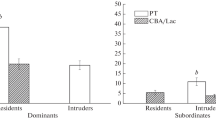Abstract
This study examines the behavioural effects of the gene for albinism (c-locus) in mice. For this purpose, homozygous albino mutants were compared with heterozygous pigmented mice, all males, in three experimental situations: 1. In order to obtain a general picture of the behavioural phenotype, the frequencies of 22 acts and postures displayed by solitary mice in a large observation cage were observed directly. 2. Using a platform that could be fixed at different heights, the levels and latencies of descent were recorded for the two genotypes. 3. In a pole-climbing test, the climbing latencies of the animals were measured. These experiments indicated that albinos show more fear of heights (are more acrophobic) than wild-type mice. Their visual exploration of space appears to be about normal. The problem of the causation of this acrophobia is discussed.
In one single respect (climbing latency) the mutants turned out to be more variable than the controls, a finding which might be explained in terms of a weaker canalization of their phenotype.
Similar content being viewed by others
References
Abeelen, J. H. F. van (1963). Mouse mutants studied by means of ethological methods. I. Ethogram.Genetica 34: 79–94.
Abeelen, J. H. F. van (1965).An ethological investigation of single-gene differences in mice. Thesis, University of Nijmegen, The Netherlands.
DeFries, J. C., J. P. Hegmann &M. W. Weir (1966). Open-field behavior in mice: Evidence for a major gene effect mediated by the visual system.Science 154: 1577–1579.
Grüneberg, H. (1952).The genetics of the mouse. Bibliographia Genetica XV, p. 28. Nijhoff, 's-Gravenhage, The Netherlands.
Henry, K. R. &K. Schlesinger (1967). Effects of the albino and dilute loci on mouse behavior.J. comp. physiol. Psychol. 63: 320–323.
Les, E. P. (1958).A study of the effects of single locus heterozygosity on traits which may have survival value in eight stocks of laboratory mice. Ph. D. Thesis, Ohio State Univ., U.S.A.
Levine, L. &P. L. Krupa (1966). Studies on sexual selection in mice. III. Effects of the gene for albinism.Am. Naturalist 100: 227–234.
Meier, G. W. &D. P. Foshee (1965). Albinism and water escape performance in mice.Science 147: 307–308.
Siegel, S. (1956).Nonparametric statistics for the behavioral sciences. McGraw-Hill, New York, pp. 116, 75, 213 and 68.
Waddington, C. H. (1961) Genetic assimilation.Adv. Genet. 10: 257–293.
Winston, H. D. &G. Lindzey (1964). Albinism and water escape performance in the mouse.Science 144: 189–191.
Winston, H. D., G. Lindzey &J. Connor (1967). Albinism and avoidance learning in mice.J. comp. physiol. Psychol. 63: 77–81.
Author information
Authors and Affiliations
Rights and permissions
About this article
Cite this article
van Abeelen, J.H.F., Kroes, H.W. Albinism and mouse behaviour. Genetica 38, 419–429 (1967). https://doi.org/10.1007/BF01507473
Received:
Issue Date:
DOI: https://doi.org/10.1007/BF01507473




